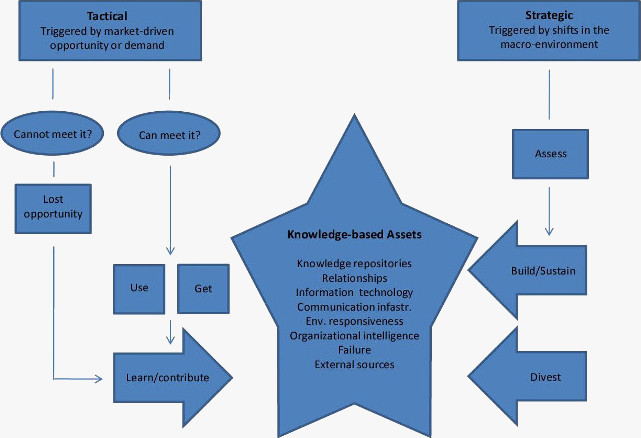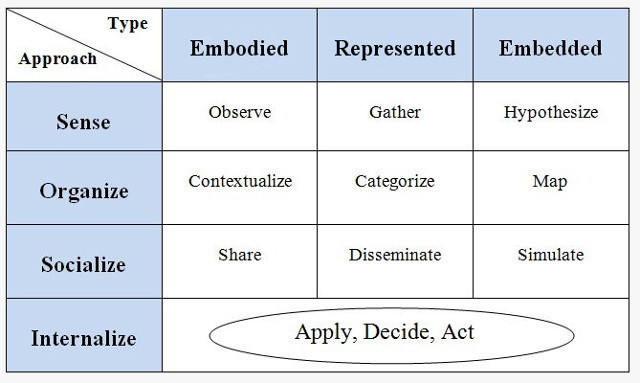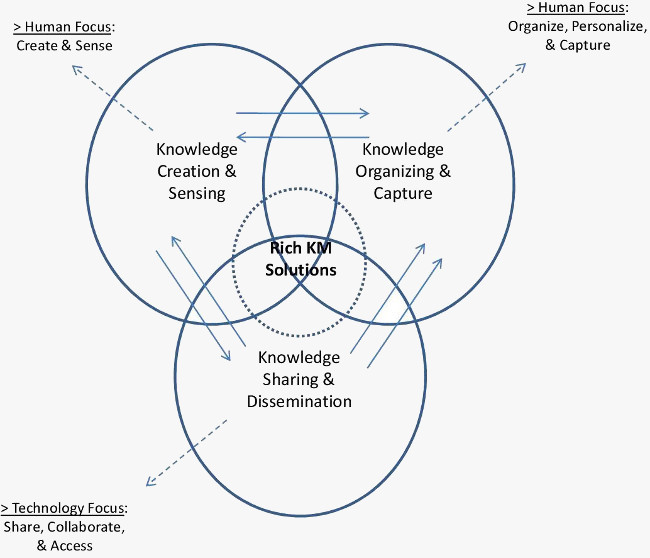In this section I will three knowledge management (KM) models that take three very different approaches to KM.
The KM Process Framework by Bukowitz and Williams (1999)

This KM model depicts the process that defines the strategy for management to build, divest, and enhance knowledge assets.It is a model that emphasizes the "why" and "when" aspects. The strengths of this model rest on its strategic focus, which essentially puts knowledge management action into context. It is also worth noting that the notion of "divestment" is included - something which is often missing from KM models.
KM initiatives are the result of the response to tactical and strategic changes and needs. The model provides a great overview of the strategy behind KM but it does not include any deeper insight into what initiatives are suitable in a given instance.
The KM Matrix by Gamble and Blackwell (2001)

This KM model presents a general theoretical framework, as well as specific guidelines for implementation..
The KM process is split into four stages. First management must locate the sources of knowledge. Then they must organize this knowledge so as to assess the firm's strengths and weaknesses and determine its relevance and reusability. This is followed by socialization, where various techniques are used to help share and disseminate it to whomever needs it in the organization. Finally, the knowledge is internalized through use.
As all sequential models, the steps are not to be taken literally, but they do provide an excellent overview of the role of the KM manager. However, one limitation of this model is its focus. First of all, the overall strategic role outline by Bukowitz and Williams is not included. Secondly, KM's role here is limited to knowledge sharing, omitting the processes of knowledge acquisition/creation and divestment. This is a perfectly legitimate approach to KM where the focus is on the sharing and retrieval of existing knowledge, but it does not fulfill the scope of the knowledge management definition outlined on this site.
The Knowledge Management Process Model by Botha et al (2008)

This model attempts to offer a more realistic overview of the KM process. The three broad categories overlap and interact with one another. Like Gamble & Blackwell, the focus is on managerial initiatives. Here too the strategic focus (the "when" and the "why" as opposed to the "what") is omitted. It is noteworthy that this model does include the creation of new knowledge as a specific KM initiative.
The model further shows which of the three categories are more people oriented and which are more technology focused. Whether or not knowledge sharing should be largely technology focused is certainly debatable and it is something that I will address in future sections. However, for better or for worse, this is largely how organizations tend to approach the issue i.e. as a technological rather than organizational and social challenge.
We have now looked at three models that take very different approaches to KM. There is one other important aspect relating to KM that has not been directly dealt with by these models. I am referring now to the measurement of effects that lets management know whether the implemented initiatives are achieving the desired results. This is dependent upon data and information management, but is paramount for future KM initiatives.
Based on these models, as well as on the topics discussed on this site so far, I will present my version of an integrated knowledge management model.
